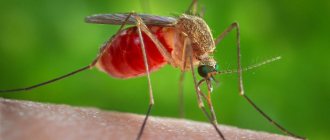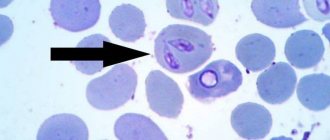The microscopic parasite, Otodektes cynotys , is a mite that causes serious damage to the tissues of the auricle. During the life of an ear mite, inflammatory processes occur, which, if not treated in a timely manner, can lead to fatal consequences such as meningitis and death. Most often in veterinary clinical practice, otitis media is diagnosed in the area of the outer ear. Less commonly, in advanced cases, the eardrum is damaged, which leads to decreased hearing in the cat or complete deafness.
Sulfur, which is secreted by the glands and accumulates in the ear canal, provides an excellent breeding ground for ear mites. Therefore, it is very important to keep your pet's ears clean at all times. Accumulations of sulfur and weakening of the cat’s immunity should not be allowed.
As a rule, a cat becomes infected with ear mites through direct contact with household items. Damage occurs when a healthy animal comes into contact with infected bowls, bedding or combs.
How could a cat become infected with ear mites?
The assumption that a domestic cat that does not have free access to the street cannot become infected with most infections, including parasitic diseases, such as otodectosis, is erroneous. The direct route of infection with ear mites is contact. A healthy cat can be in close contact with a sick animal, its hygiene items, bedding or dishes. The owner himself can bring the parasite into the house from the street on his shoes. It is enough to walk in those places where homeless street animals live (not necessarily cats, but also dogs). Not only sick animals are considered carriers of otodectosis. Parasites are well tolerated by fleas and flies. Therefore, it is important to follow preventive measures and strengthen your pet’s immunity.
Routes of infection
Cats, dogs, rabbits, ferrets, birds, and rodents can suffer from otodectosis.
The most common ways cats become infected with ear mites are:
- Upon contact with a sick animal. In cities, the main carriers of otodectosis are pigeons. Those pets that are not outdoors can become infected at exhibitions or in veterinary clinics.
- When in contact with things of an infected animal: carrier, bedding, comb. Most often, this spread path can be traced in a house where several pets live.
- Through the owner's shoes and clothing, on which the parasite is brought into the house from the street.
Symptoms of ear mites in cats
Signs of a cat being infected with ear mites are quite specific. When the first symptoms of pathology appear, it is not recommended to self-medicate. The best solution would be to go to a veterinary clinic and see a specialist. Characteristic signs of otodectosis in a cat are:
- the appearance of anxiety, constant shaking of the head, plaintive calls, characteristic tilts of the head towards the affected side;
- severe itching, in an attempt to cope with which, the animal begins to actively attempt to scratch itself against furniture or corners;
- the appearance of an unpleasant odor from the ear canal area, accompanied by specific discharge, which later becomes purulent in nature;
- formation of characteristic dried brown crusts in the auricle and around it.
Lack of timely treatment leads to the development of dangerous complications. First of all, the inflammatory process caused by the activity of ear mites moves into more distant structures of the ear, right up to the brain. In this case, the symptoms will be more pronounced. In addition to anxiety, the animal will have an unsteady gait, an increase in body temperature, and a non-physiological arching of the head in the direction of the lesion. In some cases, seizures and convulsions are observed, resulting in death. To prevent this, it is necessary to seek help from a qualified specialist as soon as possible, at the first signs of anxiety in your pet.
What does an ear mite infestation look like?
Knowing the symptoms of the disease will help you notice the infection in time and contact a veterinarian.
Timely diagnosis will allow timely treatment to begin and prevent the development of the disease.
- Stage 1. The cat appears restless and sometimes shakes its head. Slight redness appears on the inside of the ear. Lasts up to 2 weeks from the moment of infection.
- Stage 2. The animal begins to eat poorly, itch on various surfaces, and the fur stops shining. Due to the spread of ear mites, foci of redness occupy a much larger area of the inner ear than in the first stage of the disease. Brown discharge similar to coffee beans appears. The duration of this stage is from 14 to 21 days from the moment of infection.
- Stage 3. The cat is constantly worried, scratches its ears, and does not allow anyone to touch its head. The inner surface of the ear is covered with brown discharge mixed with dry crusts. There is a rotten smell. This condition can last up to three months.
Ear mite
Most often, at stage 3, the disease becomes chronic. Complications occur in weakened animals and kittens due to low immunity.
Are ear mites dangerous for cats?
Ignoring the signs of otodectosis for a long time leads to the development of serious complications. First of all, ear mites are dangerous for the development of deafness. Often, with the development of an inflammatory process provoked by a parasite, the addition of bacterial pathogenic microflora is noted. All this aggravates the further course of the underlying disease.
Moving deeper, the inflammatory process leads to rupture or perforation of the eardrum. The cat begins to hear worse, and over time becomes completely deaf. In severe cases, inflammation of the meninges may develop. In this case, saving the animal is quite difficult.
Are ear mites transmitted from cats to humans?
Pet owners, especially if there are children in the house, are concerned about whether ear mites are dangerous for humans. Otodectosis is not transmitted to people. However, when parasites get on human skin, they can cause discomfort, itching, and redness. Symptoms disappear on their own after the pet is cured and do not require medical intervention.
In medicine, there are isolated cases where an ear mite was transmitted to a person from a cat and caused otitis externa.
The exceptions are:
- those suffering from an allergic reaction to parasite waste;
- when scratches become infected at the site of bites.
In this situation, you must immediately seek medical help.
Thus, the risk of people becoming infected with ear mites from a cat is minimal.
Treatment for ear mites in cats
After confirming the preliminary diagnosis of otodectosis, the doctor begins to develop treatment tactics. The animal’s weight, gender, living conditions and breed predisposition are taken into account. First of all, the specialist cleanses the ears from accumulated exudate by introducing antiseptics. Next, special medications are administered in the form of liquids. For these purposes, special ear drops are designed to destroy pathogenic microorganisms and relieve the inflammatory process.
Antiacaricidal agents should be selected by a veterinarian. This is due to the fact that such drugs contain toxic substances, the main task of which is to destroy the tick. The dosage must be selected individually. Otherwise, the risk of intoxication of the body cannot be excluded. As soon as the medicinal solution is introduced into the auricle, it is necessary to thoroughly massage its base, allowing the drug to be well distributed over the surface of the affected inner part of the auricle.
Powdered medications are also used to treat ear mites in cats. They are poured into the ear canal and massaged in the same way as in the case of drops. Specially developed ointments and gels applied to the inside of the auricle have a good therapeutic effect.
During the general course of therapy, antimicrobial agents are also included to suppress the activity of bacterial microflora, anti-inflammatory drugs (antihistamines) and immunomodulatory agents that increase the overall resistance of the body.
Getting rid of ear mites is not an easy task. Therapy is carried out in cycles every 7-10 days. In some cases, treatment with antiparasitic drugs should be carried out at intervals of 5-7 days. This cyclicity is due to the life cycle of the tick. Tick eggs are more difficult to destroy, so treatment is aimed at eliminating adult individuals.
Diagnosis of ear mites
It is important not to confuse otodectosis with other ear diseases with similar symptoms (for example, dark discharge in the ears (exudate) can also be from a yeast infection).
And using anti-tick medications where there are none can make the situation worse. Therefore, for an accurate diagnosis, as always, we go to the doctor. The diagnosis is based on anamnesis (history from the owner), clinical signs and laboratory data.
It is not difficult to diagnose otodectosis, since the ear mite is quite large. It can be seen using an otoscope with a magnifying glass and a light.
For laboratory testing, a scraping is taken from the inside of the ear, the contents of which are laid out on a glass slide and examined under a microscope. Under slight magnification, transparent white ticks are visible - dead ones are motionless, living ones are actively moving.
Folk remedies for ear mites in cats
Despite the abundance of traditional medicine recipes for combating various diseases in animals, including ear mites, they are all useless. Thus, in some sources there is advice on using onions or garlic pulp to treat otodectosis. These products are unlikely to have a detrimental effect on the tick itself, but it is possible to achieve severe irritation of the skin already damaged by the actions of the tick. Moreover, instilling onion juice into the ear canal can lead to complete hearing loss.
Of the folk recipes, you can only use those that are auxiliary to the main treatment. For example, green tea has an antiseptic effect. You can wipe the outer part of the ear canal with a cotton pad soaked in tea leaves, softening and removing crusts. Hydrogen peroxide may be suitable for cleansing. It must be remembered that instilling it into the ear canal is prohibited. The solution is only allowed to wipe the external auditory canal, like green tea.
To clean the ear canal from scabs and crusts, you can try using sunflower or olive oil. It must be remembered that the oily base creates a specific film on the surface of the skin, which leads to poorer absorption of beneficial substances from medications prescribed by a veterinarian.
Symptoms of the disease
Finding out that your pet is infected is quite simple. The disease has characteristic symptoms that are not similar to other diseases. During their life, mites secrete saliva and feces, which cause severe itching and irritation on the skin.
Symptoms of otodectosis:
change in behavior: the cat shakes its head, tilts it to one side, becomes restless, meows, rubs its ears against protruding surfaces;- the appearance of dark, foul-smelling discharge from the ear, pus;
- dark (brown) flaky crusts form inside the ears, it looks like dried blood.
The inside of a healthy animal's ear is always clean and odorless. Normally, the discharge is light yellow in color. The appearance of thick masses in the form of dirt, blood, pus is a clear sign of infection.
Ignoring treatment
If there is no treatment in the early stages of infection, the inflammation penetrates into the ear, as the animal constantly scratches it, abrasions and wounds form. Microbes enter them and a secondary infection occurs.
As a result, otitis media is diagnosed, and in advanced cases, inflammation of the meninges. In this case, the pet’s body temperature rises, it throws its head to the side, and seizures occur.
The consequences of neglected otodectosis are sad: the animal dies.
How long does it take to treat ear mites in cats?
Depending on the severity of the pathology, treatment periods will vary. Unfortunately, many owners turn to the veterinarian with this problem when a sharp unpleasant odor appears from the cat’s ears, a specific exudate is released and pathogenic microflora is present. In this case, the duration of treatment will be from 1.5 to 2 months. This is due to the fact that the development cycle of the otodectosis mite is from 5 to 7 days. It is not possible to find out 100% how many eggs a female tick was able to lay. Therefore, to completely defeat the disease, otodectosis is treated with courses.










